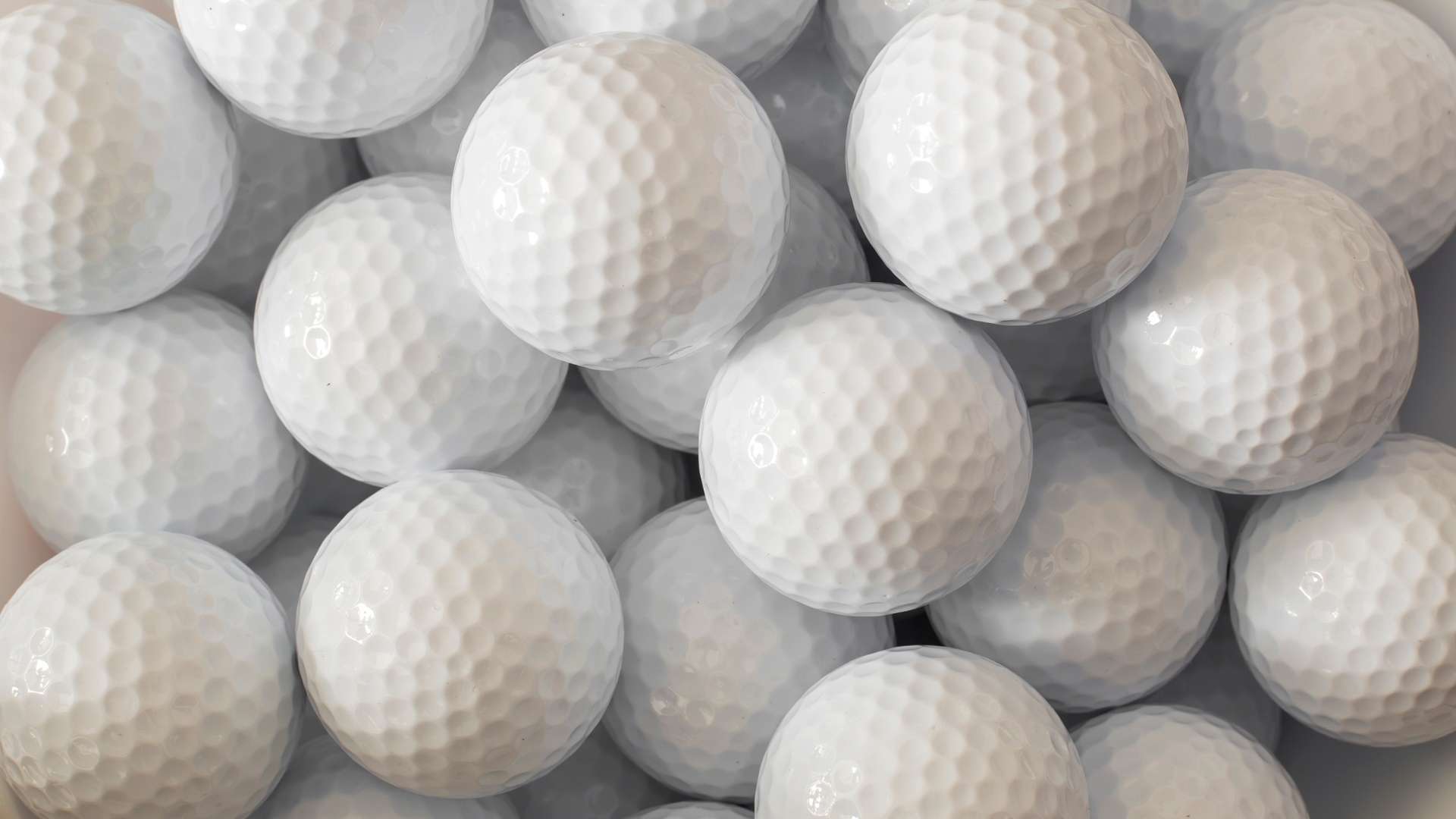A standard golf ball has 336 dimples. These dimples vary in size and pattern based on the manufacturer.
Golf balls feature dimples to enhance their aerodynamic properties. Dents reduce air resistance and increase lift, allowing the ball to travel farther and more accurately. Each manufacturer designs their dimple patterns to optimize performance. The number of dimples can range from 300 to 500, with 336 being the most common.
The arrangement and depth of these dimples are crucial for consistent flight. Golfers often choose balls with specific dimple patterns to match their playing style. Understanding how dents affect performance can help players improve their game. Whether you are a professional or a beginner, selecting the right golf ball is essential.
Introduction To Golf Ball Design
The design of a golf ball impacts its performance significantly. Understanding this design helps players improve their game. One essential aspect of golf ball design is the dimple pattern. These tiny dents on the surface affect how the ball flies and rolls.
History Of Golf Balls
The first golf balls were made of wood. These balls were heavy and did not travel far. In the 17th century, “featherie” balls emerged. These were leather pouches stuffed with feathers. Featherie balls were more aerodynamic but costly and fragile.
By the mid-19th century, the “gutty” ball was introduced. Made from the sap of the Gutta-percha tree, gutty balls were cheaper and more durable. Players soon noticed that scuffed balls flew better. This observation led to the intentional design of surface patterns.
Evolution Of Dimple Patterns
Modern golf balls have a complex dimple pattern. The first dimpled ball appeared in the early 1900s. These dimples reduce air resistance and improve lift. Over time, designers tested various patterns to find the best configuration.
Today, a typical golf ball has between 300 and 500 dimples. The number and shape of dimples can vary. Some balls have shallow dents, while others have deep ones. Engineers continue to experiment with dimple patterns to optimize performance.
Here’s a table summarizing the evolution of golf ball design:
| Era | Material | Notable Features |
|---|---|---|
| 1600s | Wood | Heavy, short flight |
| 1600s-1800s | Feathers, Leather | Better flight, fragile |
| Mid-1800s | Gutta-percha | Durable, cheaper |
| 1900s-present | Synthetic materials | Dimpled surface, optimized flight |
Purpose Of Dimples
Ever wondered why golf balls have dimples? These tiny dents play a crucial role in a golf ball’s performance. The primary purpose of dents is to enhance the ball’s aerodynamics and control. Let’s dive into the specific benefits of these dimples.
Aerodynamics And Lift
Dents on a golf ball help manage air flow. This boosts both lift and distance. Without dimples, a golf ball would not travel as far. The dimples reduce air resistance, known as drag.
They create a thin layer of air that clings to the ball’s surface. This layer reduces the wake behind the ball, allowing it to travel smoother. The ball cuts through the air more efficiently. As a result, it can stay in the air longer and go farther.
Impact On Ball Control
Dimples also help in controlling the ball’s flight path. They make the ball spin, which is vital for control. More spin means better control of direction and distance.
Golfers can use spin to their advantage. For example, backspin can make the ball stop quickly on the green. Side spin can help in making curved shots like a slice or hook. This spin control can greatly impact the game.
Dents give golfers more precision. This allows for better shots, especially in tricky situations.
Standard Dimple Count
Golf balls have a specific number of dimples. These dimples affect the ball’s flight. Understanding the dimple count is crucial for golfers. It helps in choosing the right ball for their game.
Common Numbers In Modern Balls
Most modern golf balls have between 300 and 500 dimples. This range ensures a good balance of lift and drag.
Some popular dimple counts include:
- 336 dimples: Found in many brands.
- 392 dimples: Offers a different flight pattern.
- 420 dimples: Used for specific playing conditions.
Variations Across Brands
Different brands use different dimple counts. Each brand aims to optimize performance. Here are some examples:
| Brand | Dimple Count |
|---|---|
| Titleist Pro V1 | 352 |
| Callaway Chrome Soft | 332 |
| Bridgestone Tour B XS | 330 |
Some brands experiment with different patterns. They aim to improve aerodynamics. This can lead to unique dimple designs.

Credit: www.stackerinc.com
Science Behind Dimples
Golf balls have around 300 to 500 dimples. These dimples are not just for looks. They play a crucial role in the ball’s performance. Each dimple affects the ball’s flight, spin, and distance.
Physics Of Flight
Dents on a golf ball reduce drag. Drag slows down the ball. With dimples, the ball can fly farther. The dents create tiny pockets of turbulence. This turbulence reduces the drag.
Role In Spin And Distance
Dimples also affect the ball’s spin. Spin helps control the ball’s direction. More spin can mean more control. Less spin can mean more distance. The right balance is key.
| Dimples | Effect |
|---|---|
| 300-500 | Optimum performance |
| More than 500 | Too much turbulence |
| Less than 300 | Not enough lift |
- Drag: Reduced by dimples
- Spin: Increased by dimples
- Distance: Improved by dimples
- Dimples create turbulence.
- Turbulence reduces drag.
- Less drag means longer flights.
Understanding dimples can improve your game. Next time you play, think about the science behind each swing.
Manufacturing Process
The manufacturing process of a golf ball is fascinating. Each step ensures the ball meets quality and performance standards. Knowing this process helps understand why golf balls have many dents or dimples.
Design And Prototyping
The first step is design and prototyping. Engineers use computer software to design the ball’s shape and dimple pattern. The number of dimples is crucial for aerodynamics. Most golf balls have between 300 and 500 dimples. The design must balance distance and control.
Once the design is ready, a prototype is created. This involves making a sample ball to test. Engineers then test the prototype in wind tunnels and on golf courses. Feedback is used to refine the design. The goal is to achieve the best performance.
Production Techniques
After finalizing the design, the production process begins. The core is the first part made. It is usually a rubber-based material. The core provides the ball’s initial velocity. It is then covered with layers of materials. These layers affect the ball’s feel and spin.
Next, the dimples are added. This is done by placing the ball in a mold with the dimple pattern. The ball is heated and compressed to form the dimples. The number and depth of dimples affect how the ball travels through the air.
Once dimples are added, a final cover is applied. This cover is typically made of urethane or other durable materials. It protects the ball and affects its durability and feel. The ball is then painted and stamped with a logo.
Finally, the balls undergo quality control checks. They are tested for size, weight, and performance. Only balls that meet strict standards are packaged for sale.
| Step | Description |
|---|---|
| Design | Using software to create shape and dimple pattern |
| Prototyping | Creating and testing sample balls |
| Core Production | Making the ball’s core from rubber-based material |
| Dimple Molding | Adding dimples using heated molds |
| Final Cover | Applying a durable cover and logo |
| Quality Control | Testing for size, weight, and performance |

Credit: m.youtube.com
Testing And Quality Control
Golf balls undergo rigorous testing and quality control to ensure they meet standards. The number of dents, or dimples, in a golf ball affects its performance. This section explores how manufacturers test and control the quality of golf balls.
Performance Testing
Performance testing evaluates how a golf ball behaves in play. This includes measuring distance, accuracy, and spin. Manufacturers use high-speed cameras and sensors to gather data. The tests simulate real-game conditions to ensure accuracy.
- Distance: How far the ball travels.
- Accuracy: How straight the ball flies.
- Spin: How much the ball spins in the air.
Data from these tests helps adjust the number of dimples. This ensures the ball performs well under various conditions.
Durability Assessments
Durability assessments check how long a golf ball lasts. Tests include hitting the ball repeatedly and exposing it to different conditions. Machines simulate thousands of hits to see if the ball maintains its shape and performance.
| Test | Purpose |
|---|---|
| Repeated Impact | Ensures the ball can withstand many hits. |
| Temperature Exposure | Checks how the ball performs in different climates. |
| Water Resistance | Ensures the ball does not absorb water. |
Durability tests are crucial for maintaining the quality of golf balls. The number of dimples must remain consistent throughout the ball’s life.
Impact On Gameplay
The number of dents on a golf ball, known as dimples, plays a crucial role in its performance. These dimples affect various aspects of the game, including distance, accuracy, and control. Understanding their impact can help both professional and amateur golfers improve their gameplay.
Professional Insights
Professional golfers often pay close attention to the number and arrangement of dents on their golf balls.
- Dimples create turbulence in the air around the ball.
- This reduces drag and allows the ball to fly farther.
- More dimples can improve lift and enhance flight stability.
- Commonly, professional balls have 300 to 500 dimples.
Understanding these details can help pros make better choices. They can select balls that match their playing style and course conditions.
Amateur Experiences
Amateur golfers also benefit from understanding dimple patterns.
- Dimples help reduce slices and hooks for beginners.
- They provide more control, especially in windy conditions.
Amateurs often choose balls with a balanced number of dimples. This helps them achieve a good mix of distance and control.
Here’s a simple table to highlight key differences:
| Aspect | Professional Golfers | Amateur Golfers |
|---|---|---|
| Number of Dimples | 300-500 | Varies, usually balanced |
| Focus | Optimized for specific conditions | Balanced for all-around performance |
Both groups can benefit by experimenting with different balls. Understanding dimple patterns will help improve their overall game.
Future Of Golf Ball Design
The future of golf ball design is bright and promising. Advances in technology and sustainable practices are shaping new trends. These innovations aim to enhance performance and reduce environmental impact.
Innovative Technologies
New technologies are revolutionizing golf ball design. Engineers use 3D printing to create precise dimple patterns. This technique offers better control over aerodynamics.
Another breakthrough is the use of nanomaterials. These materials enhance the ball’s durability and performance. They also make the ball lighter and faster.
Artificial Intelligence (AI) plays a key role. AI helps in designing balls with optimal dimple placement. This ensures maximum distance and accuracy.
Sustainable Materials
Golf ball manufacturers are turning to eco-friendly materials. These materials are biodegradable and reduce pollution.
Bamboo and recycled plastics are popular choices. These materials offer the same performance as traditional ones. They also help in conserving natural resources.
Another trend is the use of water-based coatings. These coatings are safer for the environment and provide better performance.
| Material | Benefits |
|---|---|
| Bamboo | Eco-friendly, durable |
| Recycled Plastics | Reduces waste, high performance |
| Water-based Coatings | Non-toxic, enhances durability |
Using sustainable materials does not compromise performance. It offers a win-win for golfers and the planet.

Credit: tomorrowgolf.com
Frequently Asked Questions
How Many Dimples Are There On A Golf Ball?
A golf ball typically has 300 to 500 dimples. The exact number can vary by manufacturer and model.
How Many Grooves Does A Golf Ball Have?
A golf ball typically has 300 to 500 dimples. The exact number varies depending on the manufacturer and model.
How Many Dimples Are On A Titleist Golf Ball?
A Titleist Pro V1 golf ball typically has 352 dimples. The exact number can vary slightly between different models.
What Are The Dents In Golf Balls Called?
The dents in golf balls are called dimples. Dimples help improve aerodynamics, allowing the ball to travel farther and more accurately.
Conclusion
Understanding the number of dents in a golf ball can improve your game. Each dimple plays a crucial role. Knowing this detail helps you choose the right ball. Next time you play, pay attention to the dimples. Your game might just get better with this newfound knowledge.





